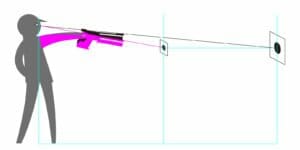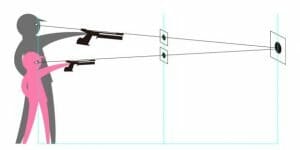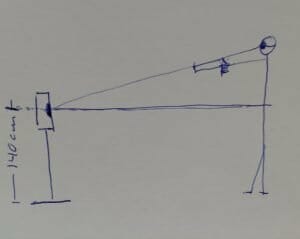Calculate target size and height online or download the target size and height calculator
When I train at home I can never have the right distances to set my targets, so I end up shooting much shorter distances. This generates two problems:
- The angle of my arm is not right,
- and the size of the target is too big.
So I decided to create and share a target calculator to figure out what was the right height and size of the black bullseye depending on the distance.
Table of Contents
But the Target Height Does Not Change, It Is an Official Measure!
Of course it does not, but relative height and size do. Even if the target is at a fixed height, as you move far from it the angle of sight changes and the target seems to go up. Two shooters with different height will have different arm angles.


Images by accu-labo.com
You want to keep your arm angle even if the target is at 2 meters instead of 10. Do a test, point at something with your hand and move back keeping your arm steady in the same position: you will see how the target goes up!
The size of the target also changes because what you care about is keeping the apparent size, so that the black looks to be the same size over your front sight. If you look at a dot in the wall or at your target and you start walking back, you will see how it becomes smaller and smaller.
And What About Shot Points?
As soon as you reduce the distance scoring is no longer relevant: the holes are bigger, the grouping is tighter (less distance for angle errors to follow), and the ballistics are not the same (specially at longer distances).
There’s a lot of dry firing work, get the best out of it.
The Math
I solved these problems using basic maths and the triangle calculations of the Pythagorean Theorem, and the imaginary straight line that goes from my eye, through the sights, to the aiming area.
What I’ve done is create a right triangle with vertex (the corners of the triangle) at the height of the center of the target and also the center of my eye.
Knowing the distance from myself to the target at home I can calculate the size of the triangle and with it the height: to keep the same line of sight angle I have to raise the distance line.
How to Use the Target Size and Height Calculator
Download the calculator. To use it you just have to put on your shooting shoes and have someone measure the distance from the floor to the center of your eye while in shooting position. Then you can adapt the fields that have a yellowish background to your needs, starting by choosing an event from the list under Event.
I have included official heights and sizes of the black for different ISSF events to the right, the light blue cells. You can use them as reference or measure at your club (the height of the target in mine is at 141.5cm, well within the 5cm allowance of the ISSF for air pistol), but it may be good that you change it a bit regularly, as not all ranges setup the targets at exactly the same height. You want to be able to learn to get the right sensations even if there are changes.
There’s a Custom row to add any other discipline that you are interested in. If you send me the official distances and sizes I will paste them to the calculator.
There is an unaccounted small distance also from the 10m mark to your eye, so this should have a small impact on the angle of your arm. I’ve not yet figured out how much to add. It may not be precise enough for a rocket, but it should be more than precise enough for shooting 🙂
To print the targets you have the total size in the bottom and also the relation to the original size (as a number, a fraction and a percentage). You can get some PDF targets here and use the printing dialog to scale it to the needed size. Check with a ruler afterwards that the size is good.
Happy training!
Download the target size and height calculator
Calculate size and height of target
Only the cells in yellow are editable. Add the height of your shooting eye from the floor, the distance at which you are shooting now, and choose the discipline from the drop down. If your discipline is not included, choose Custom in the drop down list and add your data in the Custom cells in the bottom right, under the blue disciplines.
Download the target size and height calculator if you want to keep the file in your computer.
Official target sizes and heights
ISSF pistol and rifle
| Disciplines | Distance | Black Diameter | Height of target |
| 10m Air Pistol | m 10 | cm 5.95 | cm 140.00 |
| 25m Precision Pistol | m 25 | cm 20.00 | cm 140.00 |
| 25m RF Pistol | m 25 | cm 50.00 | cm 140.00 |
| 50m Free Pistol | m 50 | cm 20.00 | cm 75.00 |
| 10m Air Rifle | m 10 | cm 3.05 | cm 140.00 |
| 50m .22 Rifle | m 50 | cm 11.20 | cm 75.00 |
I would love to add the target size and height for other associations like NRA. Please send the table my way so that I can paste it in the calculator and here 🙂


Having trouble accessing. Is the link current? Thank you!
Thanks a lot for the heads up William. I’m working on it.
It should be working now. Can you please check William? Thanks!
Hi Ramon I have no drop down list in events? Once I have my height what is next calculation?
Lara
Hi Lara.
Weird. You should see a small triangle in the yellow cell under Events. If you don’t have it there, please download it again or make a new copy to your Google Drive. Send me the file by email (ramon at olympicpistol.com) so that I can investigate.
Height is to your eye, not total height.
After including this you just enter the real distance to the target and choose an event from the list, then the results change automatically.
Please let me know if it is working for you.
Hello,
I cant thank you enough for this calculator. Not only my concentration is improved (because I always used to get nervous that am I at the correct height and distance ratio ). Your calculator + Scatt = awesomeness!
Thanks!
Hey ramon i am not able to download the file..can you please send me via email.
It should be in your mailbox now. Can you describe the issue you encountered to download it? Maybe I have to fix something. Thanks!
It is fixed now. Thanks for your email 🙂
I’m not sure if you considered this, but the diameter of the pellet may also need to be taken into account if you plan to “score” your shots on your scaled down range. For example, if shooting at 5 meters instead of 10 meters, the pellet will still make a 4.5mm hole in the paper. But, for scoring purposes, the desired hole at this range would be about half of that size. If you do not adjust the ring size to compensate for the pellet diameter, your scoring will appear to be higher than it actually is. If (for 5 meters) you reduce the diameter of all of the scoring rings (Not the black circle) on the target by 2.25mm, you will get a more realistic score. Note: The seven ring will end up NOT aligning with the BLACK circle when the scoring rings are scaled for scoring. The black circle should be scaled based only on the distance so that you have a consistent sight picture.
There’s no scoring to do when shooting at a reduce distance. It would be too complicated to find the center of each shot and adapt it, and still it would not take into account the angular error that would be magnified at a bigger distance. Some electronic targets try to do this but they do not take into account the angular error either. SCATT may take into account that angular error, but I don’t know for sure.
Another thing to take into consideration is that parallel errors are amplified when shooting at a reduced distance (you can see an explanation in the linked electronic target reviews).
So no printing with rings, useless. Use this target sizes and heights with electronic targets that allow to shoot at reduced distances, SCATT, to dry fire, or to shoot at a paper target but without taking into account the shots, just like dry fire practice but with the feedback of the projectile being shot and leaving the gun.